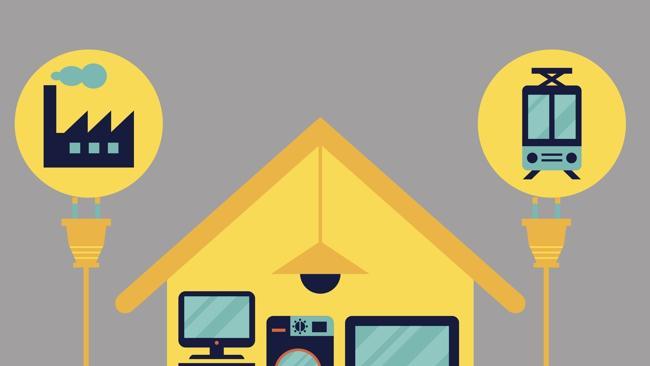The internet at home: connected together forever
THE internet of everything changes our homes profoundly.

THE technology to connect everything in the home to the internet is here: you can control light bulbs, door locks, thermostats, coffee machines, power plugs, speakers and cameras as part of your home network.
It is dubbed “the internet of things”, a fully internet-connected home and it was on display at CES 2015 — the world’s biggest consumer electronics show held last week in Las Vegas.
The future is now: your coffee machine from UK firm Smarter starts brewing as soon as a sensor registers you walking through the front door, your Big Ass Wi-Fi ceiling fan automatically switches to night mode when it senses you are asleep (thanks to the Jawbone Up health tracker on your wrist), while the next morning your Kevo front door deadlock tells your Google Nest thermostat that you have left home and please switch off the airconditioner.
An SNS (simple notification service) can be sent to your smart TV or even to a set of wirelessly connected Bose speakers.
Giant strides have been made in home security.
You no longer have to be home to know if someone has entered your house: someone walks through your front door or activates a window sensor or security camera, you’ll find out via the internet.
Netatmo’s Welcome smart home camera even recognises different family members, and texts you when they come and go. It also notifies you if someone not on file appears — possibly a burglar.
But while the very DNA of the internet of things is its connectiveness, don’t imagine this new market is manifesting itself as an orderly release of home automation gadgets working in harmony.
The competition between vendors is ruthless and they all want your home automation business.
Apple, Google, Samsung, Philips and a string of third-companies have built systems for controlling your smart home. Their connected devices use different systems for wireless communication: Low energy Bluetooth (Apple), Z-Wave (Google), Zigbee (Philips), Wi-Fi and old fashioned RF (radio frequency) used for flying model aircraft are the main ones. Some devices will talk with those from another manufacturer, others won’t.
In the US, several smaller manufacturers are producing home automation hubs — little black boxes that communicate with connected devices. Some of these will come to Australia. SmartThings (now owned by Samsung), Insteon, AlertMe, and Staples Connect are examples. Bigger firms such as Belkin and Philips have their own proprietary networks.
So the home user seeking to install the connected home needs to shop around, be aware of the various choices, and select one that will deliver the type of home automation they want.
Once you have settled on a connected home system, you can make endless cause and effect linkages between devices — such as what gets turned on or off when you leave home or come home, go to sleep, walk downstairs. The choices are endless. But beware of your home automation spiralling out of control from forgetting the instructions you gave devices months ago.
Locally, home automation will arrive in one of two ways, either pre-installed in new houses and apartments or retrofitted by consumers themselves. The Iris Home Management System, for example, is largely DIY, consisting of more than 60 connected products: lights, cameras, door locks, energy meters, garage door openers, curtain and blind controllers.
Iris plans to launch here, a representative told The Australian. In the US, it is backed by home improvement chain Lowes, so its products are likely to appear in local retail outlets. But Iris charges users $US10 ($12.24) per month — it’s not free.
Lighting has been a prime target for home automation and long-lasting intelligent light bulbs are getting cheaper. It’s just a matter of adding a small mass produced chip to a bulb to make it internet-connected.
Some smart light bulbs such as those made by Sengled are more elaborate, and include a concealed camera, infra-red sensor, or even a speaker, so you can use your smartphone to talk to people at your front door, who hear you through your porch light.
Using a phone to switch off a light is nothing new. But it was pretty tedious. Frankly, it was much easier to use a regular wall switch. But smart light switches that you let you program a whole series of actions into one switch flick appeared at CES.
Philips, for example, has produced a Hue Tap switch with four programmable buttons. Set one button to switch a series of loungeroom lights and lamps to home cinema mode, another button turns reading lights on, etc.
Soon, you’ll be able to press a single programmable button to switch your lighting, airconditioning and heating to a bespoke preference. The difference is that there is no wiring. These switches communicate with the home wirelessly.
And don’t forget the family car. BMW showed off a system it is developing with Samsung that lets a driver automatically summon their BMW i3 electric car.
A smartphone app or even a Samsung smartwatch remotely starts the car, which drives automatically from the garage to outside your door. But that’s only after your garage doors remotely open. The car has sensors on its front bumper to make sure it doesn’t hit obstacles.
Sound farfetched? BMW admits it has huge legal and safety obstacles to overcome before any such system becomes reality. The tragedies we too often hear of toddlers being run over by their parents’ car in the family driveway suggests BMW will have an almighty tussle with regulators before it can launch its system.
Whatever the case, the connected home is here. You will soon be able to buy all the components for it that you need. But it’s a matter of understanding and harnessing this technology. You need to know what will truly be worthwhile, time saving and energy saving for you. Only then will you be able to make your purchasing choices wisely.
Chris Griffith travelled to CES in Las Vegas courtesy of Acer, Sony and Samsung


